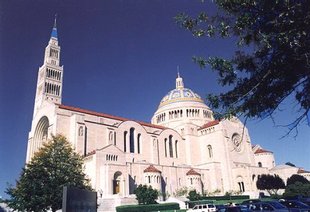Basilica of the National Shrine of the Immaculate Conception
|
|
The Basilica of the National Shrine of the Immaculate Conception is a prominant minor basilica of the Roman Catholic Church in the United States dedicated to the patron saint of the nation. An important Marian shrine that took over a century to build to its present state, it receives millions of pilgrims from around the country and the world each year. It is located at 400 Michigan Avenue in northeastern Washington, DC on land donated by Catholic University of America. Construction continues today. It is designated as a National Historic Landmark on the National Register of Historic Places.
The Basillica is often confused with the Washington National Cathedral, an Episcopal church chartered by Congress that serves occasionally as a gathering place for the nation.
Contrary to popular belief, the Basilica is neither the cathedral church of the Archdiocese of Washington nor the mother church of the nation. The Cathedral of St. Matthew the Apostle serves as mother church of the archdiocese, and since there is no American primate, the closest candidate for mother church of the nation would be the Basilica of the National Shrine of the Assumption of the Virgin Mary due to Baltimore's historical and ceremonial precedence in the American church.
| Contents |
Patroness of the United States
In 1792, John Carroll, the Bishop of Baltimore and America's first Roman Catholic bishop, consecrated the newly created American nation under the protection of the Blessed Virgin Mary under her title of Immaculate Conception. In 1847, Pope Pius IX formalized Bishop Carroll's acclamation as the pope himself officially proclaimed the Immaculate Conception as patroness of the United States. In subsequent years, a few priests imagined an elaborate shrine in honor of their country's patroness.
Establishment
Basilicaofthenationalshrineinterior.jpg
Thomas J. Shahan, bishop and fourth rector of the Catholic University of America proposed the construction of a national shrine to commemorate the Immaculate Conception in the country's capital. Bishop Shahan took his appeal to Pope Pius X on August 15, 1913. Bishop Shahan received the pope's enthusiastic support and made a personal contribution of USD $400. Bishop Shahan returned to the United States and persuaded the Board of Trustees of the Catholic University of America to donate land at the southwest corner of the campus for his shrine.
In January 1914, Bishop Shahan published the first issue of Salve Regina, a newsletter meant to stir enthusiasm for his project. He wrote that the shrine would be a "monument of love and gratitude, a great hymn in stone as perfect as the art of man can make it and as holy as the intentions of its builders could wish it to be." His newsletter was circulated to dioceses throughout the country and financial donations began to pour into Washington, DC. In 1915, Father Bernard McKenna of Philadelphia was appointed by Bishop Shahan as first director of the national shrine, bringing the bishop's dream one step closer to reality. Bishop Shahan would oversee the construction of the shrine till his death on March 9, 1932. His body would be the only one interred at the national shrine.
Cornerstone and Construction
By 1919, architectural drawings were chosen by Bishop Shahan and Father McKenna for the construction of the national shrine by a Boston firm. At first a traditional Gothic architectural style was considered. Bishop Shahan's wanted his shrine to be bold and glorious and opted instead for a Byzantine-Romanesque design. James Cardinal Gibbons, Archbishop of Baltimore, blessed the foundation stone on September 23, 1920. More than 10,000 people attended the mass, including foreign ambassadors, United States government officials, military officers, and other dignitaries. In 1929, the Great Depression halted the construction above the crypt level. United States entry in World War II stalled plans to proceed even further.
Finally in 1953, American bishops under the leadership of John Noll, Archbishop ad personam of Fort Wayne, and Patrick O'Boyle, Archbishop of Washington, pledged to raise the funds necessary to complete the upper church of the national shrine. On November 20, 1959, thousands of Catholics gathered with their bishops for the dedication of the Great Upper Church. The construction of the Basilica continues today.
External links
- Archdiocese of Washington, DC (http://www.adw.org/home.html)
- Basilica of the National Shrine of the Immaculate Conception (http://www.nationalshrineinteractive.com/)

